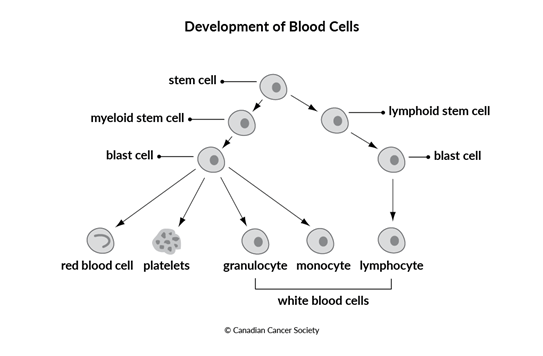What is childhood leukemia?
Leukemia is a cancer of the blood. It starts in blood stem cells. Stem cells are the earliest blood cells that develop into different types of specialized blood cells.
As the stem cells of the blood develop, they produce immature blood cells (blasts). Blasts then develop into mature blood cells.
Blood stem cells develop into either lymphoid stem cells or myeloid stem cells.
Lymphoid stem cells develop into lymphoblasts and then lymphocytes. Lymphocytes are a type of white blood cell that help fight infection and destroy abnormal cells. The 3 main types of lymphocytes are B cells, T cells and natural killer (NK) cells. B cells make antibodies that help fight infection. T cells destroy damaged and infected cells in the body and tell B cells to make antibodies. NK cells attack cancer cells or cells that are infected with a virus.
Myeloid stem cells
develop into different blasts (myeloblasts, monoblasts, erythroblasts and
megakaryoblasts), which then develop into
Leukemia causes an overproduction of blasts. These blasts develop abnormally and don’t develop into mature blood cells. Over time the blasts crowd out normal blood cells so that they can’t do their jobs.
There are many different types of leukemia. Types of leukemia are grouped based on the type of blood stem cell they look like. Lymphoid leukemia develops from abnormal lymphoid cells. Myeloid leukemia develops from abnormal myeloid cells.
Types of leukemia are further grouped based on how quickly the leukemia develops and grows. Acute leukemia starts suddenly, developing within days or weeks. Chronic leukemia develops slowly over months or years.
Acute lymphoblastic leukemia (ALL) is the most common type of leukemia diagnosed in young children. It occurs more often in boys than girls. Acute myelogenous leukemia (AML) is less common than ALL.
Rare types of childhood leukemia and leukemia-like disorders can also develop. These include transient abnormal myelopoiesis (TAM) (also called transient leukemia), acute promyelocytic leukemia (APL), juvenile myelomonocytic leukemia (JMML), chronic myelogenous leukemia (CML) and myelodysplastic syndrome (MDS).

